HANNOVER AND THE HARZ
Electric Freights and Steam Passengers
Germany - 15 to 24 February 2017 - Report by Duncan Cotterill
INTRODUCTION
A late February trip to northern Germany in the hope of getting some snow and sunshine. The principal destination was the metre gauge Harzer Schmalspurbahnen, running through the Harz Mountains on the former East/West German border. The report also covers my modern traction activities before and after the main part of the trip.This page contains the main report summarising the trip. Detailed daily observations can be found here.
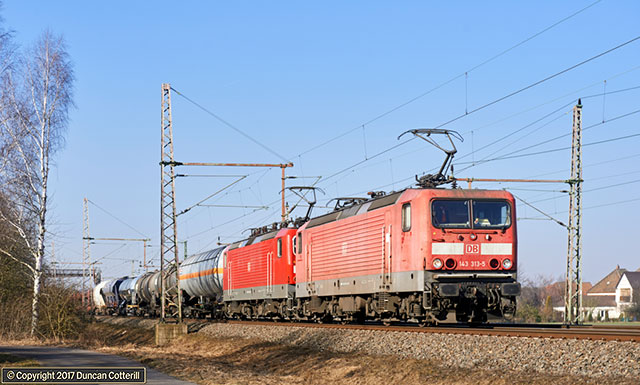
Trabbis on Freight
Since my last trip to the Hannover area, 18 months ago, DB Cargo has drafted in large numbers of redundant DB Regio Class 143 electrics. These locos were originally designed for mixed traffic work and seem at home dragging freights across the north German Plain.A very faded 143.313 led smarter 143.190 through Dedensen-Gümmer with an eastbound freight on the morning of 15 February 2017. During the day, more freights were hauled by 143s than by any other class.
HANNOVER AREA
Wednesday 15 February 2017After arriving at Hannover Airport on the morning BA flight from Heathrow, a GHV 3-zone day ticket was obtained from the DB ticket machine for €8.40, covering me for local rail services in the Hannover area as well as trams and buses (more info here in English including maps). I took the S-Bahn to the Hauptbahnhof, dumped my bag in a locker then continued on another S-Bahn train to Dedensen-Gümmer, a few km west of Seelze, Hannover's main freight yard. From the station, a walk of one and a bit km back eastwards brought me to the local Sportplatz, a well known train watching location.
It’s not exactly scenic and the electrification masts are a pain but it is incredibly busy for both freight and passenger trains. Network Rail’s health and safety zealots would have had a fit here, a busy four-track main line and not an inch of palisade fencing to be seen, or any other fencing for that matter. Inexplicably I didn’t see a single person hit by a train the whole time I was there.
Freight traffic was heavy, with a variety of DB Cargo locos in evidence and a lot of independents as well. Of particular note was the use of ex DB-Regio Class 143s on freights, often in pairs, the first time I have seen this in recent years. Around a quarter of DB’s 32 freights were worked by 143s, more than any other class, even the ubiquitous Class 185s, which only worked six. Most of the rest were worked by Classes 152, 155 and 189 with a single 145 and a 261 also noted. No DB Class 140s or 151s were seen.
The independent sector (including foreign operators) was well represented with 27 freights to DB’s 32 during the five and a half hours I was there. The diversity of traction was even greater with no fewer than 14 different classes in use, everything from 140s and 143s to 187s and 193s as well as a few diesels, all in a bewildering variety of liveries.
The traffic hauled wasn’t quite so varied with many block trains of new cars and plenty of car carriers in almost every mixed freight. There were also block trains of gas and oil tanks, containers, grain hoppers, steel, timber and vans but cars predominated. Most were going west but there were some eastbound loaded car carriers as well as plenty of eastbound empties.
Passenger services through Dedensen-Gümmer had also changed considerably since my last visit with the disappearance of the hourly Class 111 hauled DB Regio-Express services to Bielefeld and Rheine, replaced by new, double-deck Stadler Class 445 EMUs operated by Westfalenbahn.
DB Regio seem to have lost most of the regional passenger services in the Hannover area to the independent sector but do still operate the hourly REs to Bremen and Norddeich with 146s on the west end of double-deck push-pull sets. S-Bahn services in the Hannover area are still worked by DB Class 424 and 425 EMUs.
The long distance market continues to be monopolised by DB with the usual 101s and ICEs recently joined by new DB Fernverkehr Class 146 worked InterCity services on the Leipzig - Norddeich and Berlin - Köln routes, both of which pass through Dedensen-Gümmer. No Class 120s were noted.
SBB Cargo On Tour
SBB Cargo’s 482.045, probably on hire to a German operator, headed west with a block train of new cars in the middle of the afternoon. A westbound IC (hauled by a Class 101) overtook on the passenger lines.Independents and foreign operators accounted for almost half the 60 freights seen at Dedensen-Gümmer on 15 February 2017 and new cars were more common than any other type of freight traffic.
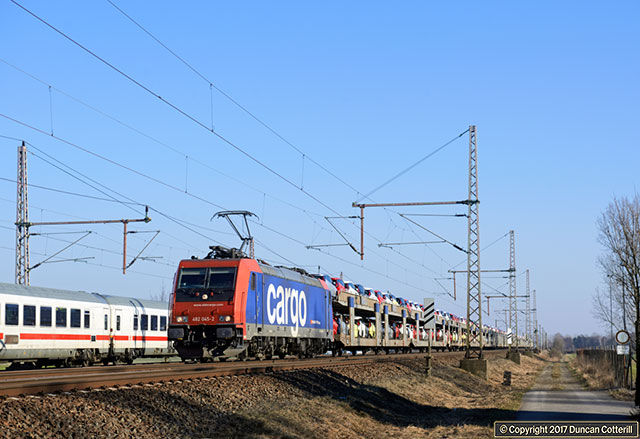
By 17:00 there were too many shadows and I was suffering from number grabbing exhaustion. It’s wasn’t just getting the numbers but getting the right numbers. Some operators are OK but others put at least two different numbers on their locos, one of which might be the true identity of the loco.
Time to call it a day, catch the S-Bahn back into town, retrieve my bag and head for our hotel in Langenhagen, the Wegner, booked through Booking.com. The hotel is on tram route 1 so I decided to get accustomed to the metre gauge by taking the U-Bahn route 1 from the Hbf, which miraculously becomes tram route 1 as it emerges from it’s burrow under the city centre. After checking in, it was time to walk to Langenhagen Mitte to catch the S-Bahn to the airport where I was to meet the others. Fortunately the evening flights from Birmingham and Manchester were early and we had soon collected our hire car and returned to the hotel in time for a couple of beers before the bar closed.
An early start the next morning, ohne Fruhstuck, got us to Wernigerode in good time for the first steam working up the hill.
Time to call it a day, catch the S-Bahn back into town, retrieve my bag and head for our hotel in Langenhagen, the Wegner, booked through Booking.com. The hotel is on tram route 1 so I decided to get accustomed to the metre gauge by taking the U-Bahn route 1 from the Hbf, which miraculously becomes tram route 1 as it emerges from it’s burrow under the city centre. After checking in, it was time to walk to Langenhagen Mitte to catch the S-Bahn to the airport where I was to meet the others. Fortunately the evening flights from Birmingham and Manchester were early and we had soon collected our hire car and returned to the hotel in time for a couple of beers before the bar closed.
An early start the next morning, ohne Fruhstuck, got us to Wernigerode in good time for the first steam working up the hill.
HARZER SCHMALSPURBAHNEN
16 to 22 February 2017The main objective of the trip was to photograph steam in snow and brilliant sunshine on the metre gauge lines of the Harzer Schmalspurbahnen in western Sachsen Anhalt. There wasn’t a lot of change since my last two visits and the weather hadn’t improved either. See my February 2014 Report and October 2015 report for more details of the Harz system, its history and operation. Information on current services is available on the HSB website.
Harzquerbahn and Brockenbahn
Across the Valley
The Steinbergkopf provides a good viewpoint for watching and photographing trains climbing out of Wernigerode but it’s a long hard slog up from the town, particularly on the first morning of the trip.99.7235 had just emerged from the Thumkuhlenkopf Tunnel with HSB 8931, the first steam working of the day, on 16 February 2017. Despite the slippery rails, a gradient of 33‰ (1 in 30) and a full load of eight vehicles behind the bunker, the loco made it all look easy.
We got a second view of the same train just over an hour later as it approached the summit of the Brocken, just out of shot, top right.
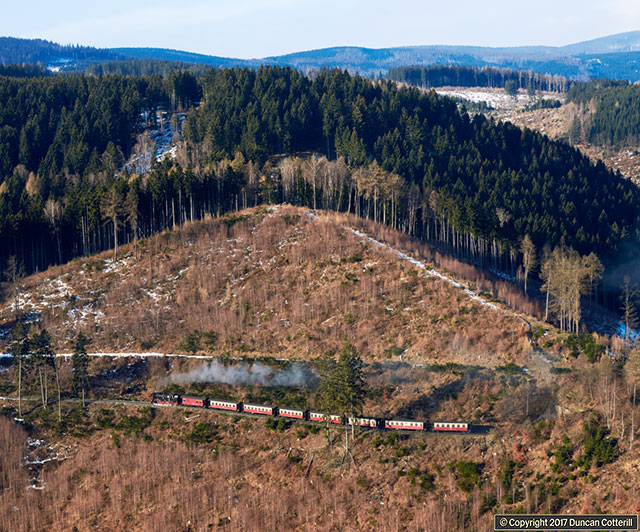
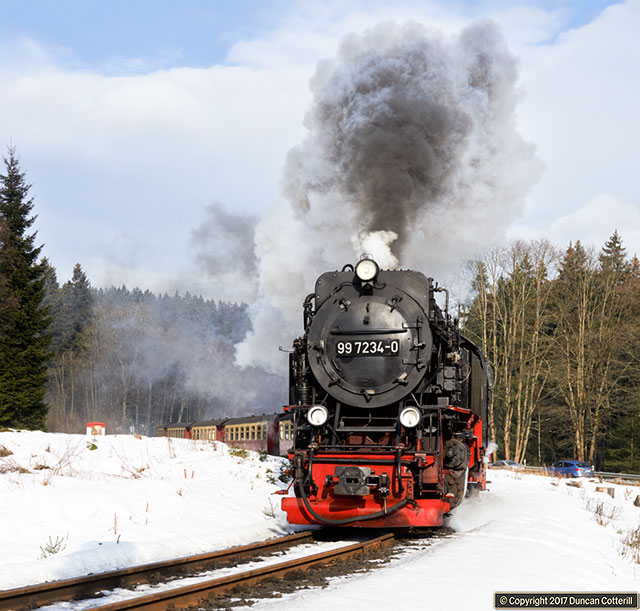
Brocken Bound
The main focus of the railway remains the transport of tourists to and from the summit of the Brocken, the highest mountain in northern Germany. Service levels vary throughout the year with four daily Wernigerode - Brocken trains at the time of our visit, plus a Wernigerode - Eisfelder-Talmühle, a Nordhausen - Brocken and three Drei Annen Hohne - Brocken workings, all booked for steam haulage.99.7234 set off from Drei Annen Hohne with train 8927, the 13:39 to Brocken, on 16 February 2017.
The loco had already been to the summit with train 8925, the 10:25 from Wernigerode, and would return to Wernigerode after its second trip to the top. This pattern of working provides a 45 minute interval service between Drei Annen Hohne and Brocken for most of the day.
Tanks On Parade
All the steam turns were worked by standard 2-10-2Ts with little swapping of locos from one day to the next. Seven different locos were seen in use over the week; 99 7232, 7234, 7235, 7237, 7239, 7243 and 7245. An eighth loco, 99.(7)236 was on shed at Wernigerode by the time we left on 22 Feb. The pre-war 2-10-2T, 99.222, which had been in regular use on the previous two trips, was in light steam at Wernigerode shed on the first evening but wasn’t seen after that.99.7232, 99.7243 and 99.7234 were lined up at Wernigerode depot on the evening of 20 February.
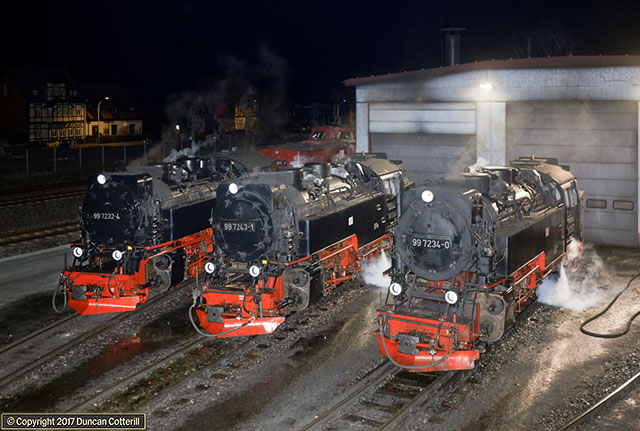
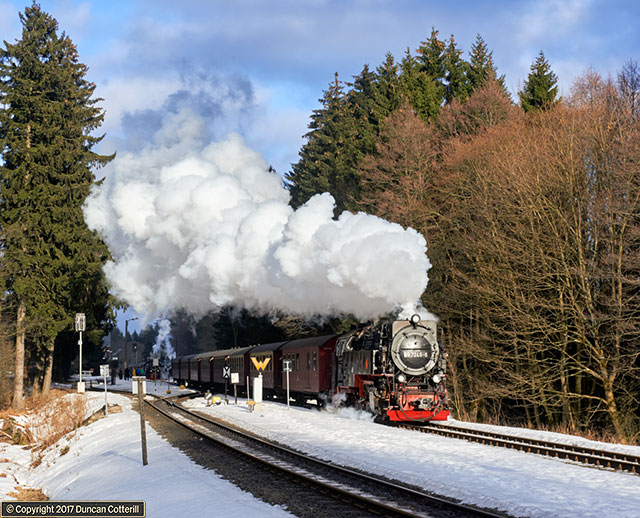
Facing South
At the start of the trip, 99.7245 was outstationed at Nordhausen, as usual, and worked all the steam turns between there, Eisfelder Talmühle and Drei Annen Hohne, swapping trains with Wernigerode based engines at DAH. Unlike the other locos on the system, it usually faces north but, by the Saturday, it was facing south, often a clue that it’s due for a visit to Westerntor Works. Sure enough, it swapped with 7237 on the Sunday afternoon and spent the rest of our visit in Westerntor. After a couple of days 7237 had been turned and was also facing north.99.7245 left Drei Annen Hohne for Nordhausen with train 8929, the 14:51 from Brocken, on Saturday 18 February.
Mallets on the Mountain
On the Saturday the semi-regular “Traditionzug” ran from Wernigerode to Brocken and back behind a pair of Mallets. With a combined age of 240 years, 0-4-4-0T Mallets 99.5901 and 99.5902 date back to the opening of the first section of the Nordhausen - Wernigerode Eisenbahn in 1897. The pair were photographed above Schierke on their way to the summit with a well loaded train in poor light.Also on the same day 99.7232 worked an 8 coach special from Gernrode to Brocken and back, a demanding 160km day for the crew and loco, involving lots of climbing with a heavy train.
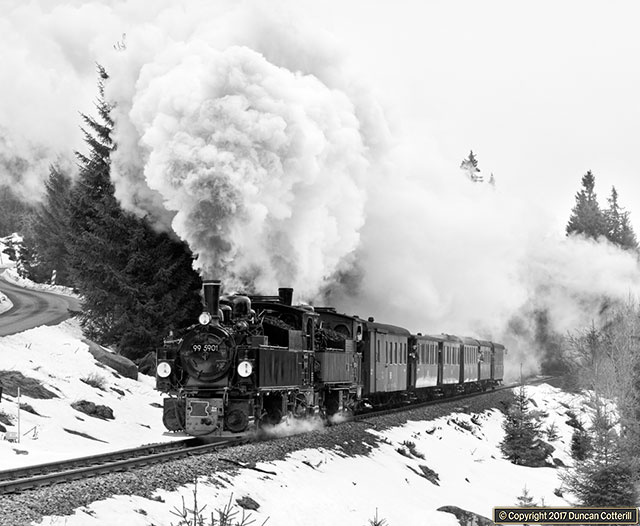
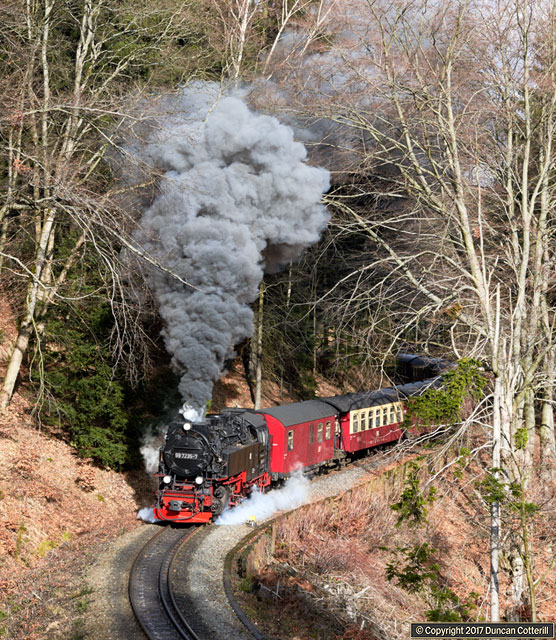
Drängetal
99.7235 emerged from the trees at the south end of Drängetal loop, halfway up the climb from Steinerne Renne to Drei Annen Hohne, on Tuesday 21 February. This was the third train of the day, 8925, the 10:25 from Wernigerode to Brocken.The daily diagrams worked as expected with the locos on the 08:55, 10:25 and 11:55 departures from Wernigerode working up to Brocken, back down to Drei Annen Hohne, back up to Brocken then down to Wernigerode. The loco on the 09:40 departure from Wernigerode worked up to Brocken then back to Wernigerode before repeating the process on the 14:55 to Brocken and 17:07 back. In each case, the locos turn round fairly smartly at their destinations and work the first available service back. Although the pattern of working within any particular day was predictable, it didn’t seem to have any bearing on which loco worked which duty the next day.
There were no diesel substitutions during our visit. Only one of the three operational Class 199 diesels was seen to move. 199.872 was in regular use around Wernigerode, ferrying dead steam locos between the shed and works and bringing empty stock from the carriage depot to the station every morning.
In addition to the steam workings, a number of services are operated by railcars and clearly marked as such in the timetable. On previous trips the ugly modern railcars built at Halberstadt in the late 1990s had virtually monopolised services but this time the two 1950s built Talbot vehicles acquired from the Langeoog Inselbahn in 1995 were also in use. I wasn’t paying much attention to the railcars but did notice that they didn’t seem to stick to the same sections of line day after day, unlike the steam locos, and a railcar seen on the Selketalbahn one day might well be seen at Wernigerode the next day.
Selketalbahn
Selketal Steam
The Selketalbahn remains a quiet backwater compared with the northern section of the Harzquerbahn or the Brockenbahn, with only one loco required to work the daily steam turns in winter. The loco does have a fairly long day though, covering virtually the whole line from Quedlinburg to Eisfelder Talmühle, including the Harzgerode and Hasselfelde branches but not the turn back loop at Stiege.99.6001 climbed from Sternhaus-Haferfeld with train 8963, the 10:30 from Quedlinburg to Alexisbad on Sunday 19 February.
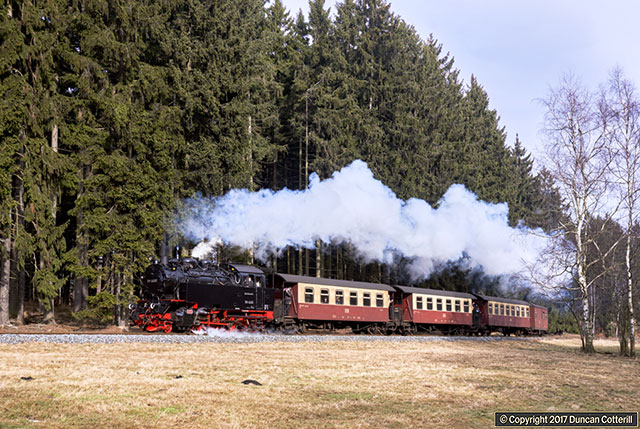
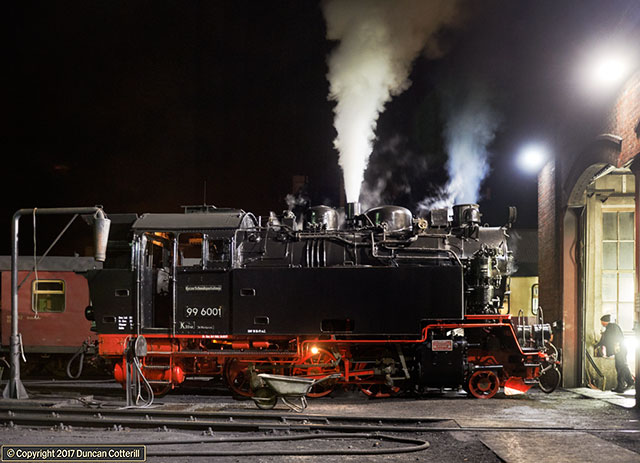
A Well Deserved Rest
99.6001 prepared to enter the shed at Gernrode at the end of the day on Saturday 18 February.This little tank is the favourite loco for working services on the Selketalbahn and is often the only operational steam loco on the line. It worked all the loco hauled service trains while we were there and seems to be a capable and well regarded machine. Just as well as it has to cover almost 200km every day, half as far again as the most demanding of the regular 2-10-2T duties.
Climbing from Stiege
99.6001 climbed away from Stiege with train 8967, the 13:57 from Gernrode to Hasselfelde, on 21 February.Apart from the steam turns, all the other service trains on the Selketalbahn were worked by railcars, as expected. As noted above, the 1950s Talbot vehicles shared duties with the 1990s built units.
One of the railcar turns is usually loco hauled for three days a week in summer, often by one of the Mallets, and it’s routed via the turnback loop at Stiege for those who require every last bit of track loco hauled.
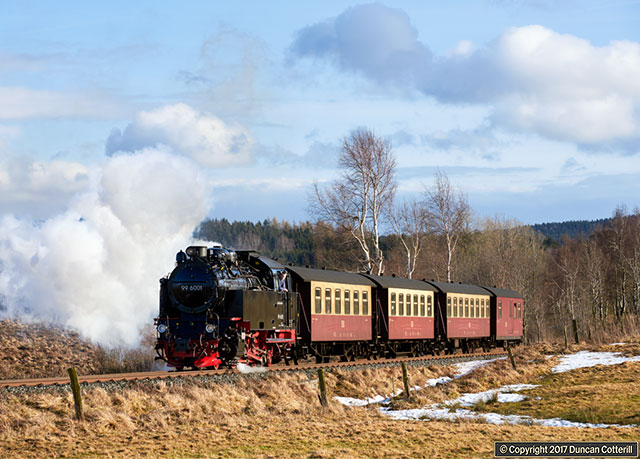
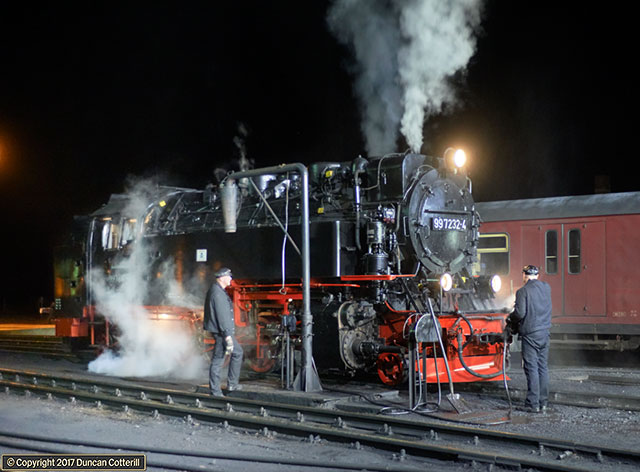
Visiting Engine
A second loco spent the nights of Friday 17 and Saturday 18 February at Gernrode. 99.7232 arrived from Wernigerode on Friday with the stock for a special to Brocken and back on Saturday. The engine and stock returned north on Sunday.The photo was taken at Gernrode shed on the Saturday evening after the train had returned from Brocken. The round trip of around 200km involvied some significant climbs and must have made the loco cough a bit as it dragged 8 fully loaded coaches up banks as steep as 25‰. The disposal crew gave the front of the loco a hose down after shovelling a large quantity of ash from the smokebox.
Photography etc
A Burst of Brightness
The weather in the Harz can be tricky, especially in winter, and this trip had more than it’s fair share of dismal light. Most days were predominantly cloudy but with some short bright periods as well. The Thursday and Tuesday mornings were fairly sunny and the sun occasionally broke through at other times but it was very unpredictable and didn’t happen very often.There was quite a lot of snow around to start with but temperatures soon warmed up and the snow quickly disappeared from the lower slopes, leaving only treacherous icy footpaths as a reminder that it was still winter. Higher up, the snow was more persistent but so was the cloud.
After a dull, overcast day the sun finally broke through just in time for the last uphill departure from Drei Annen Hohne on Saturday 18 February. 99.7235 made a smoky exit from the station with train 8937, the 14:55 from Wernigerode to Brocken.
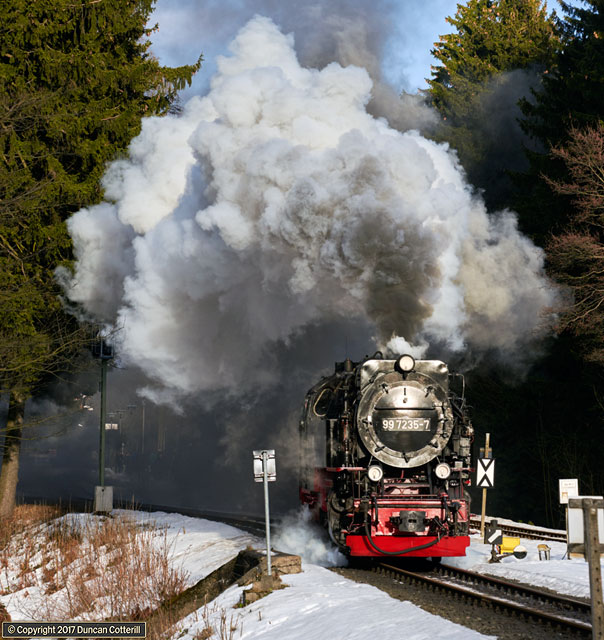
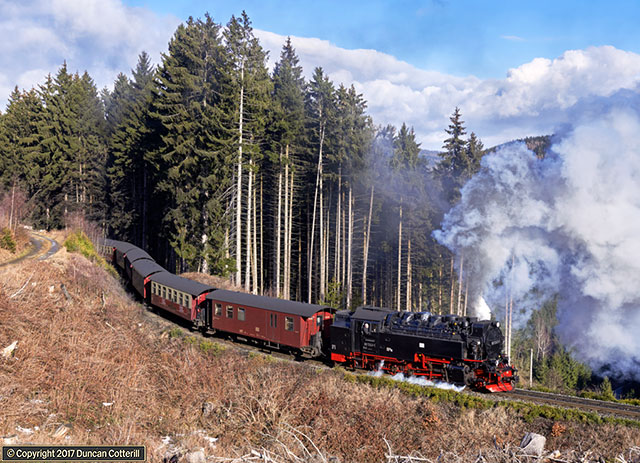
Beetlemania
Finding clear spots on the Harz system has always been difficult as much of the area is covered in dense pine forests. Enter the pine bark beetle, a tiny insect that kills big trees, and the landscape starts to open up. How much of this is directly due to beetle infestation and how much to landowners harvesting the trees while they’re still worth something is unclear but there are now gaps in the forest where there weren’t gaps before.99.7243 passed a new clearing between Drängetal and Drei Annen Hohne with train 8933, the 09:40 Wernigerode - Brocken passenger, on Tuesday 21 February.
Weather for Train Riding
99.6001 approached Alexisbad with train 8965, the 13:57 from Gernrode, on a gloomy Sunday 19 February.We resorted to train riding towards the end of the trip, looking for new locations between Wernigerode and Eisfelder Talmühle, Stiege and Eisfelder Talmühle and Quedlinburg and Alexisbad, all steam hauled of course.
A 3-day Harz Tour Card bought at the HSB’s Wernigerode ticket office for €18 provided validity, covering the entire HSB system except Schierke - Brocken. It’s also valid for travel on the big railway and buses around the Wernigerode - Halberstadt - Quedlinburg area.
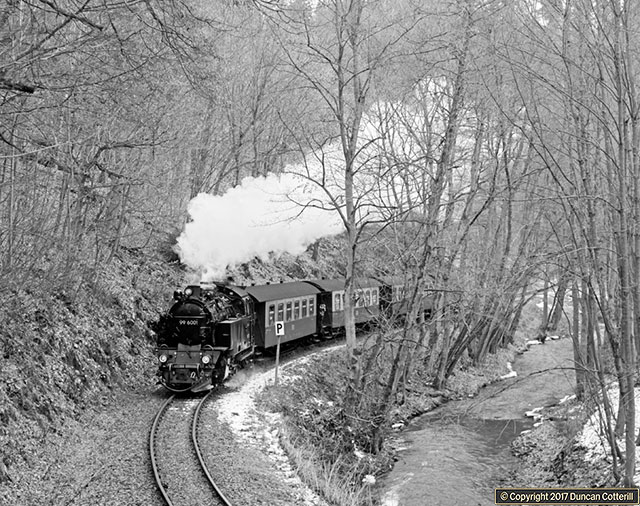
STAßFURT
Wednesday 22 February 2017Having run out of things to do on a dull day, we went to Staßfurt on the afternoon of Wednesday 22 February, in the hope that we might be able to visit the Traditions Bw. This is the preserved former DR roundhouse on the west side of the line, south of the station, and home to around 20 steam and diesel locos. Unfortunately it was closed with a notice on the gate indicating that it only opened on Sundays between 10:00 and 15:00. Information found subsequently on the Eisenbahnfreunde-Stassfurt website suggests the opening times are 10:00 to 15:30 on “working” Saturdays. The only loco visible wasn’t part of the museum collection but former DB 225.004, now owned by Ascherleber Verkehrsgesellschaft, operator of the 20km freight only branch to Egeln.
HANNOVER AND BREMEN AREAS
Wednesday 22 to Friday 24 February 2017After the end of our week on the HSB, I stayed on for a couple of days to try some more modern traction photography around the Hannover and Bremen areas.
InterCity Double Decker
A visit to Hannover Hbf on the evening of Wednesday 22 February produced this shot of 146.561 on IC 2032, the 17:38 from Leipzig Hbf to Emden Hbf.These new InterCity Class 146s and double-deck sets are now quite common in the Hannover area, working on the Leipzig - Emden and Berlin - Köln routes. I suppose the introduction of new locos for passenger service should be welcomed as it’s a rare event nowadays but I can’t get very excited about these rather bland electrics, especially as their introduction will probably lead to the withdrawal of more interesting locos, particularly 120s.
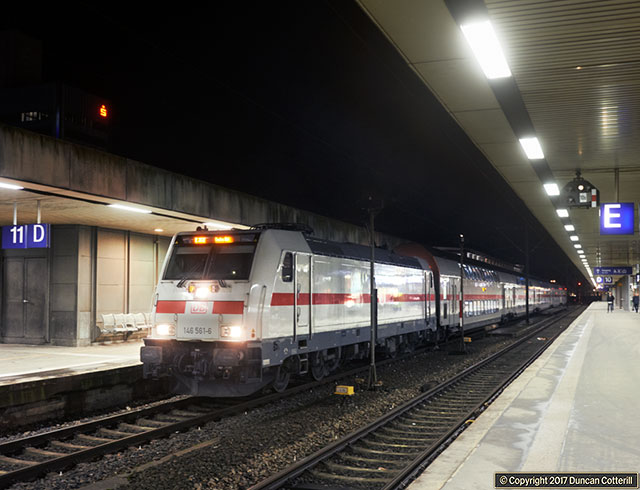
With more poor weather forecast for Thursday 23 February, I decided to spend the day travelling, checking out potential photo spots between Hannover and Bremen and having a look at the Rheine - Emden line for the first time since the end of steam in 1977. A Niedersachsen ticket (€23) was used to to get around and, as it isn’t valid before 09:00 on weekdays, I even managed a bit of a lie in.
This was the day of Storm Doris, which had mysteriously become Storm Thomas by the time it crossed the North Sea, and the TV weather forecasts were full of dire warnings about the havoc it would wreak. I did wonder whether it was wise to travel at all but decided to go anyway.
The 09:20 to Norddeich Mole, RE 4410, was formed of a DB Regio double-deck push-pull set, hauled by 146.105, and was taken to Bremen Hbf where I got off to have a look at the potential for freights passing through the station under a very photogenic overall roof. Luckily, my train had stopped at the right platform and I had time to inspect both ends of the station and get back on again before it departed for Norddeich Mole. No freight was seen between Bremen and the junction with the Rheine - Emden line at Leer, probably not surprising as it’s single track west of Oldenburg.
While the train was reversing at Leer, an ÖBB 1116 passed on a southbound car train and more freight activity was seen between Leer and Emden. Emden Rbf and the yard at Emden Hbf were full of loaded and empty car carriers and there were plenty of freight locos stabled in the area including three DB Class 145s. These locos have always eluded me and I don’t think I’ve ever seen three on an entire trip before, let alone in the same place at the same time.
North of Emden is single track again with no evidence of freight traffic. The train’s destination, Norddeich Mole is one of those stations at the far flung extremities of the system that I’ve always wondered about. I’d imagined something a bit special, somewhere with the charm of Kyle of Lochalsh or Mallaig or, at the very least, the equivalent of Westerland, with an impressive array of semaphores. The reality was a big disappointment. It’s a single track alongside a single platform with no facilities, although the nearby ferry terminal provides food and shelter, and it’s only separated from Norddeich proper by a level crossing and a few metres of track. Suppose I should have checked on Google Maps but that would have been cheating!
I left Norddeich Mole on the first available train, IC 2205, the 13:51 to Koblenz Hbf with 101.097 on the front. Länder Tickets aren’t normally valid on IC trains but there is an exception for ICs between Bremen Hbf and Norddeich Mole. It wasn’t entirely clear whether this applied to my train as it wasn’t going to Bremen but I thought it worth a try to save a long wait for the next regional train out of town. No problem. The gripper glanced at the ticket, nodded and moved on. I wasn’t even reminded that it wasn’t valid south of Leer.
This was the day of Storm Doris, which had mysteriously become Storm Thomas by the time it crossed the North Sea, and the TV weather forecasts were full of dire warnings about the havoc it would wreak. I did wonder whether it was wise to travel at all but decided to go anyway.
The 09:20 to Norddeich Mole, RE 4410, was formed of a DB Regio double-deck push-pull set, hauled by 146.105, and was taken to Bremen Hbf where I got off to have a look at the potential for freights passing through the station under a very photogenic overall roof. Luckily, my train had stopped at the right platform and I had time to inspect both ends of the station and get back on again before it departed for Norddeich Mole. No freight was seen between Bremen and the junction with the Rheine - Emden line at Leer, probably not surprising as it’s single track west of Oldenburg.
While the train was reversing at Leer, an ÖBB 1116 passed on a southbound car train and more freight activity was seen between Leer and Emden. Emden Rbf and the yard at Emden Hbf were full of loaded and empty car carriers and there were plenty of freight locos stabled in the area including three DB Class 145s. These locos have always eluded me and I don’t think I’ve ever seen three on an entire trip before, let alone in the same place at the same time.
North of Emden is single track again with no evidence of freight traffic. The train’s destination, Norddeich Mole is one of those stations at the far flung extremities of the system that I’ve always wondered about. I’d imagined something a bit special, somewhere with the charm of Kyle of Lochalsh or Mallaig or, at the very least, the equivalent of Westerland, with an impressive array of semaphores. The reality was a big disappointment. It’s a single track alongside a single platform with no facilities, although the nearby ferry terminal provides food and shelter, and it’s only separated from Norddeich proper by a level crossing and a few metres of track. Suppose I should have checked on Google Maps but that would have been cheating!
I left Norddeich Mole on the first available train, IC 2205, the 13:51 to Koblenz Hbf with 101.097 on the front. Länder Tickets aren’t normally valid on IC trains but there is an exception for ICs between Bremen Hbf and Norddeich Mole. It wasn’t entirely clear whether this applied to my train as it wasn’t going to Bremen but I thought it worth a try to save a long wait for the next regional train out of town. No problem. The gripper glanced at the ticket, nodded and moved on. I wasn’t even reminded that it wasn’t valid south of Leer.
Magnificent Machine
After leaving IC 2205 at Emden Hbf, I noticed a plinthed steam loco in the car park outside, 043.903, an engine I’d seen on the last day of regular steam in West Germany, 24 September 1977. Difficult to believe it’s been 40 years since these magnificent 3-cylinder 2-10-0s worked freights between Rheine and Emden, including the celebrated double headed 4000 tonne iron ore trains from Emden to the Saarland. The steam age went out in style with the crews driving the 043s hard and fast in their final days. Torrential downpour or not, I had to take a pic.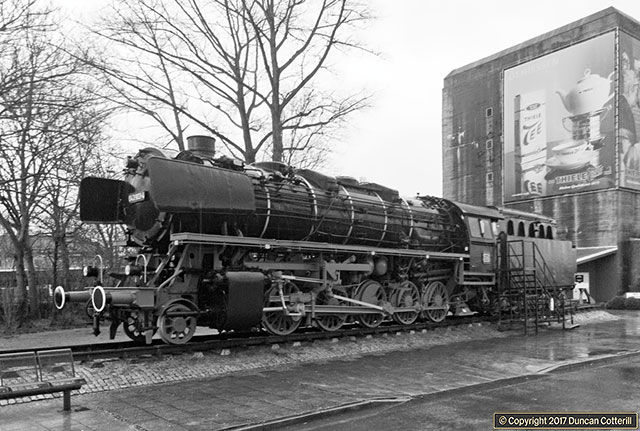
Travel south from Emden was on a pair of Westfalenbahn Class (1)428 4-car EMUs. I’d have preferred a loco hauled train but the ride on the EMU was perfectly pleasant. A number of freights were seen on the journey south to Rheine, including a 155 on a northbound steel train near Lingen. A DB 294 shunted the container terminal south of Dörpen (strange place for a container terminal) and a pair of Emsländische Eisenbahn Class 211s were seen at Meppen. It was a surprise to find semaphore signals at a number of locations on a line electrified as late as 1980.
From Rheine it was back to Hannover via Osnabruck and Minden on another Westfalenbahn EMU, this time a Class 445 double deck unit that was every bit as comfortable as the DB dostos it replaced but nothing like as photogenic. Storm Thomas did it’s worst further south and, although it was wet and windy, there weren’t any significant problems. We did have a couple of unexplained stops in the middle of nowhere during the Emden - Rheine part of the journey that could have been weather related but they cost us less than 10 minutes in total.
From Rheine it was back to Hannover via Osnabruck and Minden on another Westfalenbahn EMU, this time a Class 445 double deck unit that was every bit as comfortable as the DB dostos it replaced but nothing like as photogenic. Storm Thomas did it’s worst further south and, although it was wet and windy, there weren’t any significant problems. We did have a couple of unexplained stops in the middle of nowhere during the Emden - Rheine part of the journey that could have been weather related but they cost us less than 10 minutes in total.
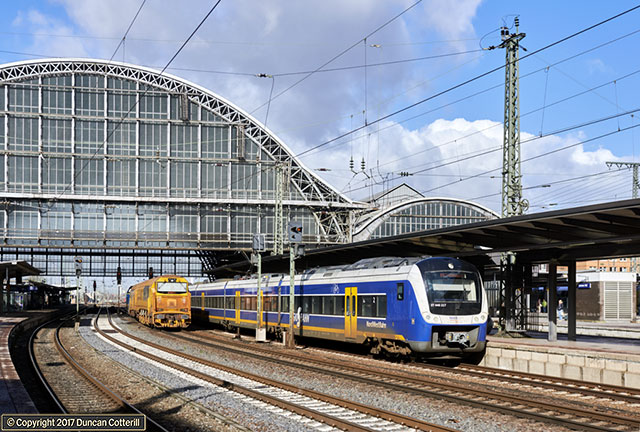
Bremen Hbf
I repeated the first part of the previous day’s journey on Friday 24 February, travelling from Hannover Hbf to Bremen Hbf on the same train behind the same loco.The first train to pass in good light was NordWestBahn’s 440.217, seen here emerging from under the roof with an S-Bahn service from Bremen-Farge to Etelsen.
It was a good decision to photograph this one as most of the NWB units were in an appalling state, plastered from end to end in hideous graffiti.
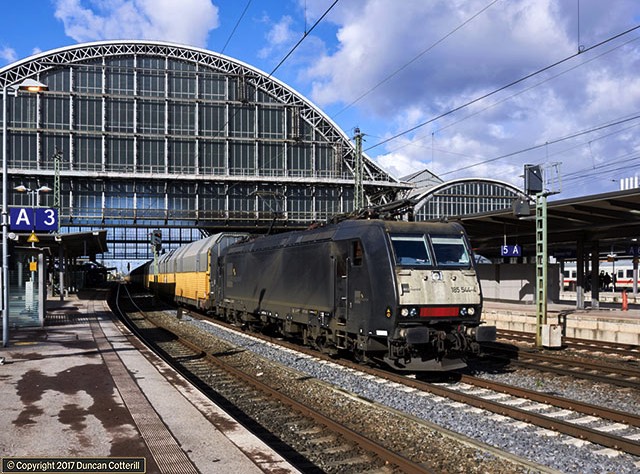
Independents Day
Around half the freights seen passing Bremen Hbf on 24 February were worked by independent operators’ locos and they seemed to be the only trains that passed in good light. Locos belonging to numerous different operators were seen, in addition to the usual Railpools and Dispoloks, including several I hadn’t been aware of until I looked them up. There’s a full list of VKMs (Vehicle Keeper Markings) on the EU Railways Agency website to help identify mystery locos.Dispolok’s 185.544 passed through the middle roads with a train of covered car carriers just after midday.
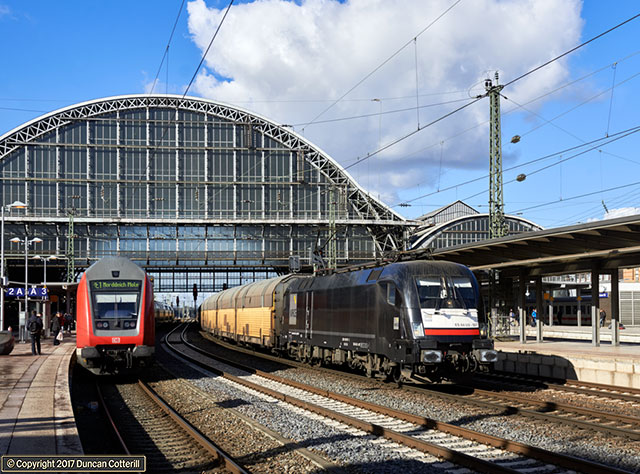
Cars, Cars, Cars
There were more trains of car carriers than any other form of freight traffic during my visit to Bremen Hbf. It was just the same the previous day around Emden and the previous week at Dedensen-Gümmer. Carrying cars appears to be big business for freight operators in northern Germany and they all seem to have a share of the action, including DB Cargo.Dispolok 182.527 wheeled another train of covered car carriers through the station on Friday 24 February, passing a DB Regio double-deck push-pull set on a Hannover - Norddeich Mole Regio-Express working.
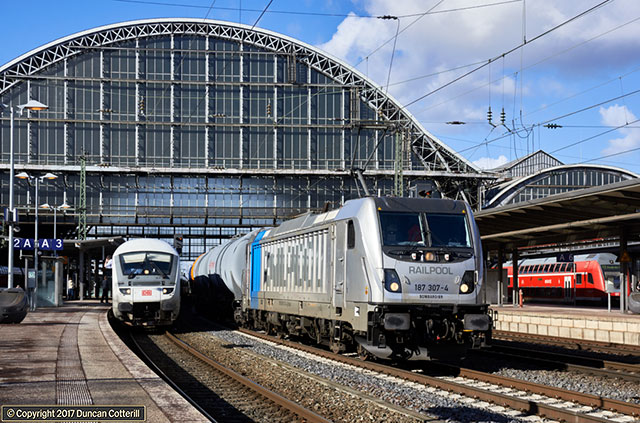
Nice When It’s Finished
Bombardier have improved the look of their standard electric loco cabs with the latest Traxx 3 design but the sides of the loco have an unfinished look, as if there should be a side panel but it’s fallen off! It could be a safety feature as the increased air resistance will aid emergency braking or it might be a way of curbing air pollution as particulates are more likely to be trapped by the corrugations than on a smooth sided loco.Railpool’s 187.307 led a train of oil tanks through Bremen Hbf on Friday 24 February.
Visiting the West End
The west end of Bremen Hbf is more photogenic than the east end but the light doesn’t get round until well into the afternoon. By the time the sun would have been on the front, the cloud had thickened up and I had to get back to Hannover for my flight home.NWB’s 440.347 and 440.221 prepared to depart with an Etelsen to Bremen-Farge S-Bahn working while DB’s 146.103 skulked in the shadows on the rear of train RE 4421, the 13:23 from Bremerhaven-Lehe to Hannover Hbf.
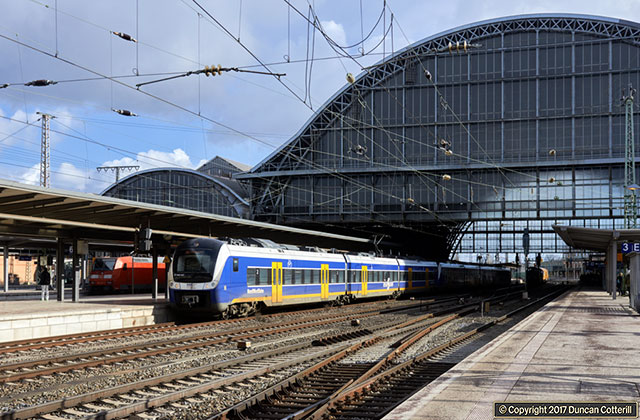
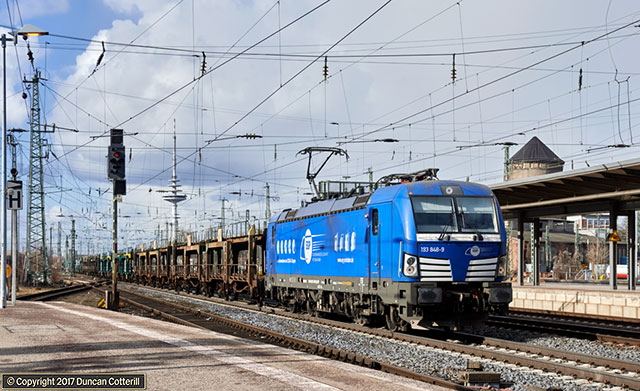
Blue Vectron
Bombardier doesn’t have a monopoly on new locomotive sales and Siemens current electric locomotive model, the Vectron, was also in evidence around Bremen and the other places I visited.193.848, registered to Eisenbahn-Gesellschaft Potsdam, approached Bremen Hbf with yet another train of car carriers, heading east in the early afternoon of Friday 24 February.
I returned to Hannover Hbf on RE 4423, the 12:39 from Norddeich Mole, propelled by 146.107, collected my bags and headed to the airport, via the S-Bahn, for the evening BA flight back to Heathrow. That was it for another trip.
My flights from Heathrow to Hannover and back were with British Airways. My companions flew from Birmingham and Manchester with FlyBe. Car hire for the seven days at Wernigerode was booked through Holiday Autos, collected from and returned to Hannover Airport.
Our hotel in the Hannover area on the first night was the Wegener in Lagenhagen, a couple of minutes walk from the Berliner Platz tram stop on line 1 or 15 minutes walk from Langenhagen Mitte S-Bahn station. It was a bit more complicated than we’d hoped in the Harz as, despite booking more than two months in advance, we couldn’t get in to our chosen hotel, the Altora in Wernigerode, for the whole week. As a result, we had a single night at the Altora, two nights at the Gasthof zum Bären in Gernrode and the final three nights back at the Altora. For my last couple of days in Hannover I stayed at the Ibis Budget at Hannover Hbf. All the hotels used were at least adequate and the Wegener and Altora were very good but also more expensive.
As might be expected in February, the weather wasn’t ideal but when the sun did come out, the light was usually bright and clear. Although there had been a lot of snow before we arrived, it quickly disappeared from the lower slopes. By the time we left, it was rapidly disappearing everywhere else, except the Brockenbahn above Schierke. We’d hoped for more snow shots but the best chance of getting the light was usually between Wernigerode and Drei Annen Hohne and that was also where new locations had been opened up by tree clearance. When the decisions had to be made, sunlight and new locations trumped snow.
The pine beetle epidemic seems unstoppable at the moment so there’s a good chance that more trees will come out, opening up more new locations. It looks like further visits will be required in the coming years.
Away from the mountains and back in the 21st Century, the extent to which DB had lost traffic to the independent sector came as a bit of a shock. Hannover Hbf was full of trains belonging to independents. Enno and Westfalenbahn have joined Metronom and Erixx since my last visit with DB Regio down to working a single main line route. At least they still have the S-Bahn, for the time being.
Bremen had even less DB Regio activity with just two main line routes remaining. Even the S-Bahn has gone independent here. At least the DB Regio services around Hannover and Bremen are still loco hauled, using Class 146.1 electrics. Even on my grand tour of north-west Germany, over 600km of travel, I don’t recall seeing a single DB Regio DMU or EMU apart from those on the Hannover S-Bahn. How things have changed.
It doesn’t look any brighter for DB in the freight sector with more independents working a greater percentage of trains than I can remember seeing before. At least the overall volume of freight seemed to be healthy. With the passenger sector getting less interesting as loco haulage decreases, freight appears to hold more promise for photography in the future, particularly as the independents don’t seem averse to using older locomotives on less demanding duties.
LOGISTICS
My flights from Heathrow to Hannover and back were with British Airways. My companions flew from Birmingham and Manchester with FlyBe. Car hire for the seven days at Wernigerode was booked through Holiday Autos, collected from and returned to Hannover Airport.
Our hotel in the Hannover area on the first night was the Wegener in Lagenhagen, a couple of minutes walk from the Berliner Platz tram stop on line 1 or 15 minutes walk from Langenhagen Mitte S-Bahn station. It was a bit more complicated than we’d hoped in the Harz as, despite booking more than two months in advance, we couldn’t get in to our chosen hotel, the Altora in Wernigerode, for the whole week. As a result, we had a single night at the Altora, two nights at the Gasthof zum Bären in Gernrode and the final three nights back at the Altora. For my last couple of days in Hannover I stayed at the Ibis Budget at Hannover Hbf. All the hotels used were at least adequate and the Wegener and Altora were very good but also more expensive.
COMMENTS & CONCLUSIONS
As might be expected in February, the weather wasn’t ideal but when the sun did come out, the light was usually bright and clear. Although there had been a lot of snow before we arrived, it quickly disappeared from the lower slopes. By the time we left, it was rapidly disappearing everywhere else, except the Brockenbahn above Schierke. We’d hoped for more snow shots but the best chance of getting the light was usually between Wernigerode and Drei Annen Hohne and that was also where new locations had been opened up by tree clearance. When the decisions had to be made, sunlight and new locations trumped snow.
The pine beetle epidemic seems unstoppable at the moment so there’s a good chance that more trees will come out, opening up more new locations. It looks like further visits will be required in the coming years.
Away from the mountains and back in the 21st Century, the extent to which DB had lost traffic to the independent sector came as a bit of a shock. Hannover Hbf was full of trains belonging to independents. Enno and Westfalenbahn have joined Metronom and Erixx since my last visit with DB Regio down to working a single main line route. At least they still have the S-Bahn, for the time being.
Bremen had even less DB Regio activity with just two main line routes remaining. Even the S-Bahn has gone independent here. At least the DB Regio services around Hannover and Bremen are still loco hauled, using Class 146.1 electrics. Even on my grand tour of north-west Germany, over 600km of travel, I don’t recall seeing a single DB Regio DMU or EMU apart from those on the Hannover S-Bahn. How things have changed.
It doesn’t look any brighter for DB in the freight sector with more independents working a greater percentage of trains than I can remember seeing before. At least the overall volume of freight seemed to be healthy. With the passenger sector getting less interesting as loco haulage decreases, freight appears to hold more promise for photography in the future, particularly as the independents don’t seem averse to using older locomotives on less demanding duties.
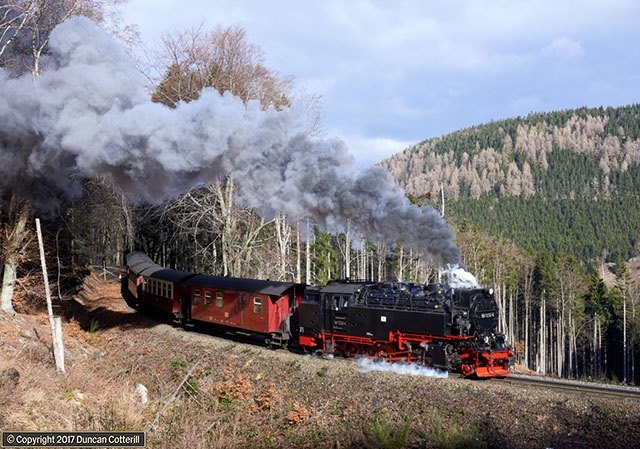
Tanks For The Memory
Although it’s a tourist line, the HSB still feels like a working steam railway, unlike the UK’s preserved lines and main line steam specials, which fail the authenticity test. Comparing my photos from 1991, when the line was still part of the DR system, and those taken over the past few years there’s not a huge difference. The locos and stock are cleaner, the stations are smarter and the track is in better condition but little else has changed.99.7232 left Drängetal behind as it made its way to Drei Annen Hohne with train 8903, the 11:55 from Wernigerode to Eisfelder Talmühle, on Tuesday 21 February.
